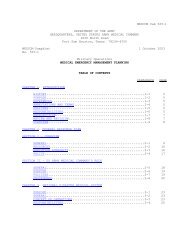(MCD) Guidelines
(MCD) Guidelines
(MCD) Guidelines
You also want an ePaper? Increase the reach of your titles
YUMPU automatically turns print PDFs into web optimized ePapers that Google loves.
<strong>Guidelines</strong> for Military Mass Casualty Decontamination Operations<br />
During a Domestic HAZMAT/Weapon of Mass Destruction Incident<br />
The primary, secondary, and tertiary decontamination levels are conducted in<br />
sequential order—the casualty, responder, and/or equipment will be cleaner at the<br />
completion of each subsequent decontamination level. However, processes such as<br />
gross, mass, and technical decontamination are often conducted simultaneously to<br />
increase the effectiveness of resource utilization. Time, sequence of events,<br />
resource availability, and desired outcome are the key drivers of the type of<br />
decontamination process applied.<br />
The combination of processes that are used to complete the primary, secondary,<br />
and tertiary decontamination cycle create a decontamination system. For example,<br />
using gross, mass, and technical decontamination for mass casualties creates a<br />
version of mass casualty decontamination. There are numerous decontamination<br />
systems in place, and they are used by both military and civilian personnel.<br />
Additional systems include patient decontamination, hospital decontamination, and<br />
mass fatality decontamination, just to name a few. Each system can be standalone<br />
or multiple systems can be used—the incident dictates how <strong>MCD</strong> operations are<br />
conducted.<br />
Figure 2 below shows the following interrelationships related to decontamination<br />
operations as a function of time, resources, and cleanliness: 13,15,23,46,47<br />
• The relationship between decontamination levels (primary, secondary, and<br />
tertiary) and processes (gross, immediate, emergency, technical, definitive,<br />
thorough, detailed, definitive, and clearance).<br />
• The correlation between military (immediate, technical, thorough, detailed,<br />
definitive, and clearance) and civilian (gross, mass, and technical) processes.<br />
Shared processes are also identified.<br />
• The relationship between the different decontamination systems, such as mass<br />
casualty, patient, and hospital decontamination systems.<br />
• NOTE: The exact terminology used by any military or civilian responder is defined<br />
by the emergency plans and procedures of the responding agencies.<br />
• NOTE: The nature and complexity of the incident, conditions, and resource<br />
availability determines the decontamination system and processes that are<br />
chosen by the Incident Commander or Commander.<br />
The top portion of Figure 2 shows the transition from the primary to the tertiary<br />
decontamination level, including the subordinate processes. The primary level<br />
provides fast decontamination and requires fewer resources, but it also removes the<br />
least amount of decontamination. Conversely, the secondary level takes more time<br />
and resources, but results in little to no contamination. The tertiary level confirms the<br />
results of secondary decontamination and routes a casualty, responder, or piece of<br />
equipment back through secondary decontamination process if any contaminants<br />
are detected.<br />
22 Original



